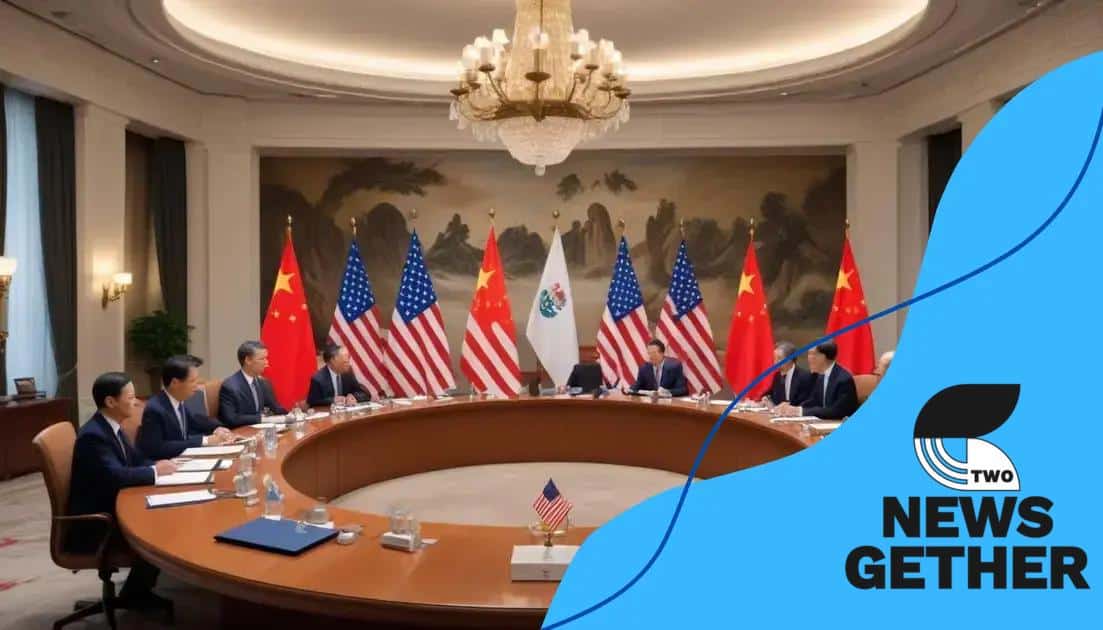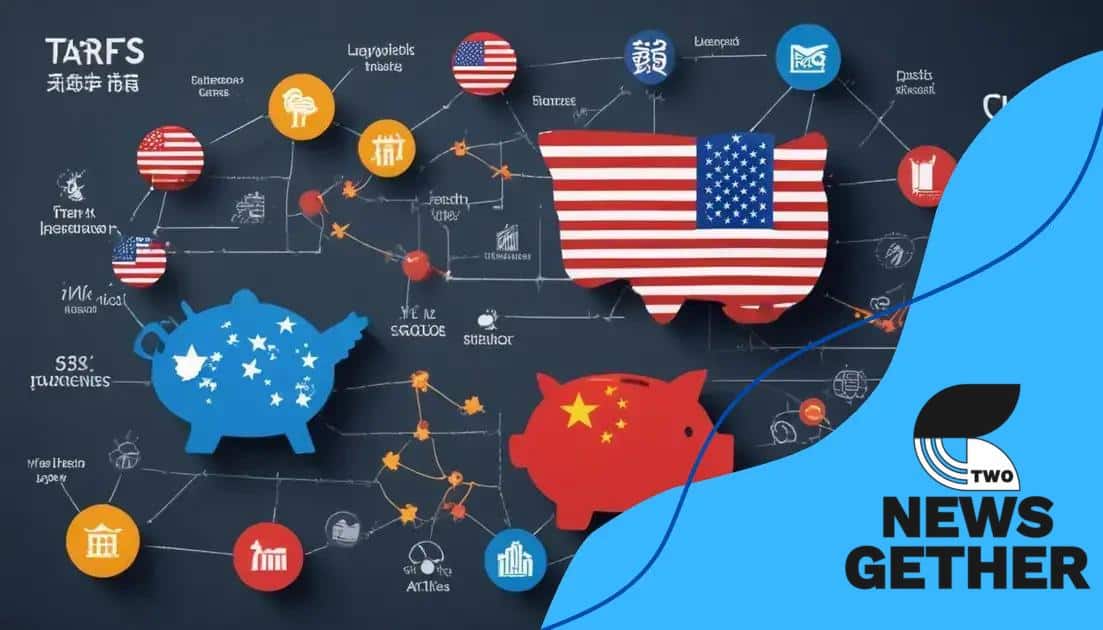US-China trade talks May 2025: what to expect

The US-China trade talks in May 2025 focus on critical issues like tariffs, intellectual property rights, and technology cooperation, significantly impacting global markets and economic relationships.
US-China trade talks May 2025 are set to shape the future of international commerce. As these two powerhouses negotiate, what can we expect for global markets and industries?
Overview of US-China trade dynamics
The US-China trade dynamics have a large impact on both economies and the world. Understanding these dynamics is key to grasping the possible implications of the trade talks in May 2025.
Historical Context
Trade relations between the United States and China have evolved significantly over the years. From the early days of cooperation to recent tensions, these shifts have influenced global markets.
Recent Developments
In 2021 and 2022, there were numerous changes in tariffs and regulations, impacting numerous industries. Companies had to adapt quickly to new tariffs, which caused prices to rise for consumers.
- Increased tariffs on steel and aluminum.
- Subsidies introduced for domestic manufacturing.
- Trade disputes leading to negotiations.
Emerging technologies have also played a crucial role in reshaping trade dynamics. The increasing reliance on technology necessitates stable trade relations for both nations to thrive economically.
Current Trade Balance
As of 2025, the trade balance remains a critical area of focus. The US has sought to manage its trade deficit while China aims to increase its exports.
- Trade balance shifts can affect employment rates.
- Changes in consumer behavior influence demand for imports.
- Political decisions can create sudden shifts.
Furthermore, public sentiment regarding trade practices is constantly changing. Polls show varying levels of support for trade agreements among the American population. This can directly impact policymakers as they negotiate.
Overall, the US-China trade dynamics present a complex web of mutual interests and challenges that will be crucial in upcoming negotiations.
Key issues on the table in May 2025
As the US-China trade talks in May 2025 approach, several key issues are likely to dominate discussions. These topics will shape the future of trade relations between the two nations.
Tariffs and Trade Barriers
One major focus will be on existing tariffs. The United States has imposed tariffs on various Chinese goods, which has affected prices for consumers and businesses alike. Reducing or removing these tariffs could foster better relations.
- Impact of tariffs on consumer prices.
- Potential for new tariffs on tech products.
- Negotiations over agricultural trade barriers.
China, on the other hand, may press for changes to policies that restrict its access to certain markets. These discussions are critical as they can significantly influence both economies.
Intellectual Property Rights
Another pressing issue is intellectual property (IP) rights. The US has long accused China of IP theft, which has strained relations. Addressing these concerns is vital to ensure fair practices.
- Revisions to IP protection laws.
- Mechanisms for dispute resolution.
- Encouraging innovation through fair competition.
Furthermore, discussions may touch on technology transfer agreements. These agreements often require foreign companies to share technology with local partners, raising concerns for US firms.
Environmental Regulations
Environmental factors are also crucial in these negotiations. Both nations face challenges related to climate change and sustainability. Collaborative efforts could lead to improved trade relations beyond economic benefits.
- Standards for emissions reductions.
- Trade of green technologies.
- Joint initiatives for sustainable practices.
Overall, the key issues on the table in May 2025 highlight the complex and multifaceted nature of US-China trade relations. Effective dialogue on these matters may pave the way for a more stable economic future.
Impact of tariffs on both economies

The impact of tariffs on both the US and Chinese economies is significant and complex. Understanding these effects is essential for grasping the future of trade relations.
Effects on Prices
When tariffs are imposed, they increase the cost of imported goods. This leads to higher prices for consumers. For example, if the US imposes tariffs on Chinese electronics, shoppers will notice increased prices at stores.
- Higher retail prices impact consumer spending.
- Businesses face increased production costs.
- Some consumers may turn to alternative products.
As a result, these changes can lead to shifts in consumer behavior, affecting overall demand for goods and services.
Impact on Employment
Tariffs can also influence employment rates in both countries. While some sectors may benefit from protective tariffs, others may suffer. For instance, US manufacturers might hire more workers due to reduced competition from imports.
- Job creation in protected industries.
- Job losses in sectors reliant on imports.
- Changes in wage levels due to market competition.
These dynamics create a balance that can affect the overall job market and economic stability.
Long-Term Economic Growth
Over the long term, tariffs can slow economic growth. High tariffs can lead to trade wars, reducing trade volumes and affecting global supply chains. Companies may seek to relocate manufacturing to avoid tariffs, which can impact domestic production.
- Disruption of established supply chains.
- Potential decrease in foreign investment.
- Concerns over future market access.
In this light, the impact of tariffs extends far beyond immediate costs, influencing strategic business decisions and economic forecasts.
The role of technology in negotiations
The role of technology in negotiations between the US and China is increasingly vital. As both nations face a rapidly changing global landscape, technology becomes a key player in shaping the discussions during trade negotiations.
Data Analysis and Strategy
Advanced data analysis tools allow negotiators to assess market trends and evaluate previous agreements. By using big data, they can identify strengths and weaknesses in trade policies and propose informed changes.
- Understanding impact through real-time data.
- Decision-making based on comprehensive analysis.
- Tailoring strategies to align with market demands.
This analytical approach can lead to more effective and efficient negotiations, potentially resulting in beneficial outcomes for both parties.
Communication Technology
Effective communication technology facilitates smoother interactions between negotiators. Video conferencing, instant messaging, and collaborative tools enable quick exchanges of ideas and documents, ensuring clarity and reducing misunderstandings.
- Enhancing direct communication channels.
- Allowing for faster responses to proposals.
- Breaking down language barriers through translation tools.
These technologies support ongoing dialogue, making it easier to reach consensus on difficult topics.
Cybersecurity Considerations
As negotiations rely more on technology, cybersecurity becomes crucial. Protecting sensitive information is essential for maintaining trust during discussions. Both nations must invest in secure communication methods to safeguard trade secrets and proprietary data.
- Implementing secure communication protocols.
- Regularly updating security measures.
- Training teams on cybersecurity best practices.
Overall, the role of technology in negotiations is multifaceted. It not only streamlines processes but also enhances the quality of discussions, leading to more favorable trade agreements.
Potential outcomes and scenarios
The potential outcomes and scenarios surrounding the US-China trade talks in May 2025 are varied and complex. Understanding these scenarios helps us anticipate the future of trade relations.
Scenario 1: Successful Agreement
If both sides reach a mutually beneficial agreement, it could lead to reduced tariffs and strengthened trade ties. This outcome would likely enhance cooperation in areas like technology and environmental sustainability.
- Increased investment from both countries.
- Expanded market access for goods and services.
- Stability in global supply chains.
A successful agreement could boost economic growth and consumer confidence in both nations.
Scenario 2: No Deal
Conversely, if the negotiations fail to produce results, the current tariffs may remain or even escalate. This scenario would lead to continued trade tensions and uncertainty in the markets.
- Increased prices for consumers.
- Negative impacts on industries reliant on imports.
- Heightened political tensions.
Such an outcome could hinder economic growth and cause job losses in sectors affected by tariffs.
Scenario 3: Partial Agreement
A third possibility is a partial agreement, where some issues are resolved while others remain contentious. This could enhance certain trade areas while leaving significant disputes unresolved.
- Potential easing of some tariffs.
- Agreement on specific sectors like agriculture.
- Continued negotiations on technology transfer.
This scenario may lead to improved relations but would not entirely eliminate uncertainty in trade practices.
Ultimately, the potential outcomes and scenarios we consider today will shape economic strategies and international relationships moving forward, making it essential for businesses and consumers to stay informed and prepared.
Global market reactions to trade talks

The global market reactions to trade talks between the US and China can significantly influence economies worldwide. These discussions often create waves of reactions based on their outcomes.
Immediate Market Responses
When trade talks commence, markets typically react quickly. Investors keep a close eye on any news or developments. Positive signals, such as indications of an agreement, can lead to market rallies.
- Stock prices may rise in response to favorable news.
- Commodities, like oil and agricultural products, could see price increases.
- Currency values often fluctuate based on trade outlook.
These immediate responses highlight the interconnectedness of global markets and the influence of US-China relations.
Long-term Economic Implications
Beyond immediate reactions, the outcomes of trade talks can have lasting impacts on global economic stability. Agreements may encourage international trade and investment.
- Strengthening ties may lead to increased foreign direct investment.
- Long-term agreements can boost confidence in markets.
- Potential for more stable supply chains improves overall efficiency.
In contrast, prolonged tensions or failed negotiations can lead to uncertainty, impacting investment decisions and economic growth trajectories.
Sector-Specific Effects
Different sectors react differently to trade talks. For instance, technology and agricultural sectors might experience immediate fluctuations based on tariffs proposed during negotiations.
- Technology stocks may fluctuate based on access to supplies and markets.
- Agricultural exports are highly sensitive to tariffs and trade barriers.
- Financial markets may adjust based on the perceived risk of trade disputes.
As such, the global market reactions to trade talks reveal the intricate relationship between politics and economics, showcasing how decisions made in one country can ripple out across the world.
FAQ – Frequently Asked Questions about US-China Trade Talks
What are the main goals of the US-China trade talks in May 2025?
The main goals include reducing tariffs, addressing intellectual property rights, and enhancing cooperation on trade and technology.
How can the outcomes of these trade talks affect global markets?
Outcomes can lead to market stability or uncertainty, influencing stock prices, currency values, and investment decisions globally.
What sectors are most impacted by the outcomes of the trade talks?
Sectors like technology, agriculture, and manufacturing are particularly sensitive to changes in trade policies and tariffs.
Why is it important to stay informed about the trade negotiations?
Staying informed helps businesses and consumers adapt to changes, anticipate market reactions, and adjust strategies accordingly.






